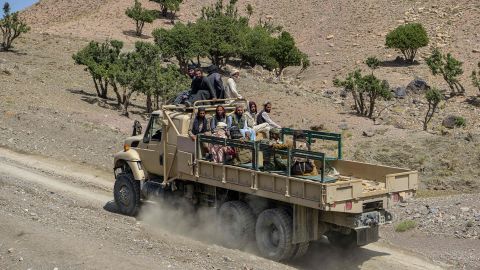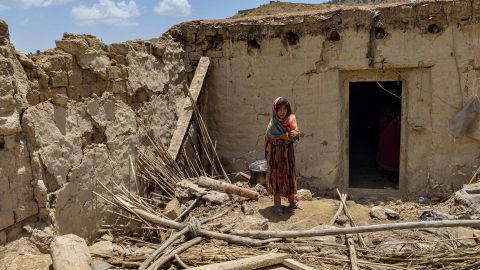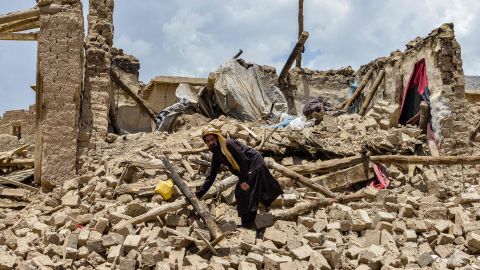CNN
,
Aid groups scrambled on Thursday to reach victims of a powerful earthquake in eastern Afghanistan that killed more than 1,000 people in a region battered by poor infrastructure, as the country grapples with a severe economic and hunger crisis.
The slow response, due to international sanctions and decades of mismanagement, concerns people working in the humanitarian sector, such as Obaidullah Bahir, lecturer in transitional justice at the American University of Afghanistan. “It’s a very patchy, band-aid solution to a problem that we need to start thinking about in the mid to long term…[another disaster]Hit?” he told CNN over the phone.
A 5.9-magnitude earthquake struck near the Pakistani border town of Khost early Wednesday and the death toll is expected to rise as several houses in the area were badly damaged by wood, mud and other materials. ,
Humanitarian agencies are mobilizing in the area, but its remote location has complicated rescue efforts.
The United Nations Refugee Agency (UNHCR) has successfully sent humanitarian aid and aid to families in Paktika and Khost provinces to meet the needs of nearly 4,000 people, a spokesman for UN Secretary-General Antonio Guterres said during a press briefing on Thursday. . ,
“Priority needs include emergency shelter and non-food items, food assistance, health and water and sanitation, as well as sanitation support,” spokesman Stephane Dujarric said.
He said the World Food Program (WFP) had confirmed that the food stock in the worst-affected Paktika province would be able to serve at least 14,000.
“At least 18 trucks are carrying emergency supplies, including high energy biscuits and mobile storage units, to the quake-hit areas,” the WFP said. Statement Released on Thursday.
UNICEF Afghanistan tweeted That they were able to distribute “sanitation kits, winter kits, emergency family kitchen kits, tents, blankets, warm clothing and tarpaulins” to affected persons in Paktika and Khost.
The search efforts and helicopter travel were hampered with heavy monsoon rains and wind-induced earthquakes between June 20 and 22.
As medics and emergency workers across the country try to reach the site, aid is expected to be limited as many organizations were forced out of the aid-dependent country after the Taliban came to power in August last year.
Those that are left are stretched thin. On Wednesday, the World Health Organization (WHO) said it had mobilized “all resources” from across the country, with teams providing medicine and emergency aid on the ground. But, as one WHO official put it, “the resources here are enormous, and not just for the region.”
The international community’s hesitation in dealing with the Taliban and the group’s “very messy bureaucracy where it becomes difficult to get information from one source” has led to communication gaps in rescue efforts, says Bahir – who is also the founder of aid group Save Afghans. Huh. , Hunger said.
“At the core of everything is how politics has translated into this communication gap, not only between countries and the Taliban, but also between international aid organizations and the Taliban,” he said.
Bahir gives an example of how he is serving as a media of information with the WFP and other aid organizations, informing them that Afghanistan’s Ministry of Defense is assisting humanitarian organizations in the most affected areas by air . providing assistance.
Meanwhile, some people spent the night sleeping in temporary outdoor shelters as rescue teams with torches searched for survivors. The United Nations says 2,000 homes are believed to have been destroyed. Photos from the worst-affected Paktika province, where the most deaths have occurred, with homes turned to dust and rubble.
Hsiao-Wei Lee, WFP’s deputy country director in Afghanistan, described the situation on the ground as “very bleak”, with some villages in heavily affected districts “completely destroyed or 70% demolished,” he said.

“Months and potentially years of construction will return,” she said. “Needs are much more than just food…
Officials say that relief is being provided to the affected areas.
According to the official Twitter account of Afghanistan’s Ministry of Defense, the government has so far distributed food, tents, clothing and other materials in the quake-hit provinces. Medical and relief teams deployed by the Afghan government are already present in the quake-hit areas and are trying to transport the injured to medical facilities and health centers by land and air.
Although the economic crisis in Afghanistan has been raging for years, the result of conflict and drought, it plunged to new depths following the Taliban takeover, which forced the United States and its allies to amass the country’s nearly $7 billion in foreign reserves. inspired to. cut internationally. funding.
There has been no US presence in Afghanistan since the hasty withdrawal of its troops and the fall of the previous US-backed Afghan government. Like almost all other countries, it does not have official ties with the Taliban government.
The sanctions have crippled the Afghan economy and sent many of its 20 million people into a severe hunger crisis. Millions of Afghans are out of work, government employees have not been paid, and the price of food has gone up.
Humanitarian aid is kept out of sanctions, but the situation in Afghanistan remains at odds, according to draft remarks by Martin Griffiths, head of the United Nations Office for the Coordination of Humanitarian Affairs (OCHA) before the UN Security Council.
This includes a major need for funding, Taliban officials “trying to play a role in selecting beneficiaries and providing aid to those on their priority list,” and “the formal banking system continues to block transfers.” ,” they write.
This means that “nearly 80% of organizations (who responded to OCHA’s monitoring survey) are experiencing money transfer delays, with two thirds reporting that their international banks are refusing transfers. 60% a More than one organization cites the paucity of available cash in the country as a programmatic constraint.

Bahir says the sanctions are “hurting us so much” that Afghans are struggling to send money to families affected by the earthquake.
“The fact that we barely have a banking system, the fact that we haven’t printed or brought new currency into the country in the last nine to 10 months, our assets are frozen… these sanctions don’t work. are,” he said. ,
He continued: “The only sanctions that give moral meaning are sanctions targeted at specific individuals, not carpets that sanction the whole country and the people as a whole.”
“While the sanctions have hit the country a lot, there are exemptions for humanitarian aid, so we’re getting it to help those most in need,” UNICEF’s Mort told CNN.
The Taliban “is not stopping us from doing anything like that, on the contrary they are enabling us,” she said.
Experts and officials say the most urgent needs include medical care and transportation for the injured, shelter and supplies for the displaced, food and water and clothing.

The United Nations has distributed medical supplies and sent mobile health teams to Afghanistan – but warned it does not have search and rescue capabilities.
Bahir told CNN on Wednesday That the Taliban was only able to send six rescue helicopters “because when the United States was leaving most of the planes were disabled, whether those belonging to the Afghan military or to them.”
According to Mohammad Ali Saif, a regional government spokesman, Pakistan has offered to help cross the border in its northern province of Khyber Pakhtunkhwa and allow wounded Afghans to come to the visa-free country for treatment.
“400 injured Afghans have gone to Pakistan for treatment this morning and people continue to come, the number is expected to increase by the end of the day,” Saif told CNN.
Pakistan has imposed strict limits on Afghans entering the country from across the land border since the Taliban came to power.